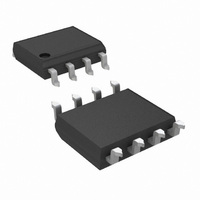LM4876M/NOPB National Semiconductor, LM4876M/NOPB Datasheet - Page 9

LM4876M/NOPB
Manufacturer Part Number
LM4876M/NOPB
Description
IC AMP AUDIO PWR 1.5W MONO 8SOIC
Manufacturer
National Semiconductor
Series
Boomer®r
Type
Class ABr
Datasheet
1.LM4876MMNOPB.pdf
(12 pages)
Specifications of LM4876M/NOPB
Output Type
1-Channel (Mono)
Max Output Power X Channels @ Load
1.5W x 1 @ 8 Ohm
Voltage - Supply
2 V ~ 5.5 V
Features
Shutdown, Thermal Protection
Mounting Type
Surface Mount
Package / Case
8-SOIC (3.9mm Width)
Amplifier Class
AB
No. Of Channels
1
Output Power
1.1W
Supply Voltage Range
2V To 5.5V
Load Impedance
8ohm
Operating Temperature Range
-40°C To +85°C
Amplifier Case Style
SOIC
Rohs Compliant
Yes
Lead Free Status / RoHS Status
Lead free / RoHS Compliant
Other names
*LM4876M
*LM4876M/NOPB
LM4876M
*LM4876M/NOPB
LM4876M
Application Information
mance can be compromised. The selection of bypass ca-
pacitor values, especially C
requirements, click and pop performance (as explained in
the section, Proper Selection of External Components),
system cost, and size constraints.
MICRO-POWER SHUTDOWN
The voltage applied to the SHUTDOWN pin controls the
LM4876’s shutdown function. Activate micro-power shut-
down by applying a voltage below 400mV to the SHUT-
DOWN pin. When active, the LM4876’s micro-power shut-
down feature turns off the amplifier’s bias circuitry, reducing
the supply current. Though the LM4876 is in shutdown when
400mV is applied to the SHUTDOWN pin, the supply current
may be higher than 0.01µA (typ) shutdown current. There-
fore, for the lowest supply current during shutdown, connect
the SHUTDOWN pin to ground. The relationship between
the supply voltage, the shutdown current, and the voltage
applied to the SHUTDOWN pin is shown in Typical Perfor-
mance Characteristics curves.
There are a few ways to control the micro-power shutdown.
These include using a single-pole, single-throw switch, a
microprocessor, or a microcontroller. When using a switch,
connect an external pull-down resistor between the SHUT-
DOWN pin and GND. Connect the switch between the
SHUTDOWN pin and V
by closing the switch. Opening the switch connects the
SHUTDOWN pin to GND through the pull-down resistor,
activating micro-power shutdown. The switch and resistor
guarantee that the SHUTDOWN pin will not float. This pre-
vents unwanted state changes. In a system with a micropro-
cessor or a microcontroller, use a digital output to apply the
control voltage to the SHUTDOWN pin. Driving the SHUT-
DOWN pin with active circuitry eliminates the pull down
resistor.
SELECTING POWER EXTERNAL COMPONENTS
Optimizing the LM4876’s performance requires properly se-
lecting external components. Though the LM4876 operates
well when using external components with wide tolerances,
best performance is achieved by optimizing component val-
ues.
The LM4876 is unity-gain stable, giving a designer maximum
design flexibility. The gain should be set to no more than a
given application requires. This allows the amplifier to
achieve minimum THD+N and maximum signal-to-noise ra-
tio. These parameters are compromised as the closed-loop
gain increases. However, low gain demands input signals
CC
. Select normal amplifier operation
B
, depends on desired PSRR
(Continued)
9
with greater voltage swings to achieve maximum output
power. Fortunately, many signal sources such as audio CO-
DECs have outputs of 1V
Audio Power Amplifier Design section for more informa-
tion on selecting the proper gain.
Input Capacitor Value Selection
Amplifying the lowest audio frequencies requires high value
input coupling capacitor (C
tor can be expensive and may compromise space efficiency
in portable designs. In many cases, however, the speakers
used in portable systems, whether internal or external, have
little ability to reproduce signals below 150 Hz. Applications
using speakers with this limited low frequency response reap
little improvement by using a large input capacitor.
Besides affecting system cost and size, C
LM4876’s click and pop performance. When the supply volt-
age is first applied, a transient (pop) is created as the charge
on the input capacitor changes from zero to a quiescent
state. The magnitude of the pop is directly proportional to the
input capacitor’s size. Higher value capacitors need more
time to reach a quiescent DC voltage (usually V
charged with a fixed current. The amplifier’s output charges
the input capacitor through the feedback resistor, R
pops can be minimized by selecting an input capacitor value
that is no higher than necessary to meet the desired -3dB
frequency.
As shown in Figure 1, the input resistor (R
capacitor, C
that is found using Equation (7).
As an example when using a speaker with a low frequency
limit of 150Hz, Equation (7) gives a value of C
0.1µF. The 0.22µF C
whose response extends down to 75Hz.
Bypass Capacitor Value Selection
Besides minimizing the input capacitor size, careful consid-
eration should be paid to value of, C
nected to the BYPASS pin. Since C
the LM4876 settles to quiescent operation, its value is critical
when minimizing turn-on pops. The slower the LM4876’s
outputs ramp to their quiescent DC voltage (nominally 1/2
V
1.0µF along with a small value of C
0.39µF), produces a click-less and pop-less shutdown func-
tion. As discussed above, choosing C
helps minimize clicks and pops.
DD
), the smaller the turn-on pop. Choosing C
I
produce a -3dB high pass filter cutoff frequency
i
shown in Figure 1 allows for a speaker
f
-3dB
RMS
i
in Figure 1). A high value capaci-
= 2πR
(2.83V
i
IN
(in the range of 0.1µF to
P-P
B
C
i
B
determines how fast
I
as small as possible
). Please refer to the
, the capacitor con-
i
I
also affects the
) and the input
www.national.com
CC
B
i
/2) when
equal to
equal to
f
. Thus,
(7)










